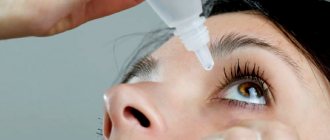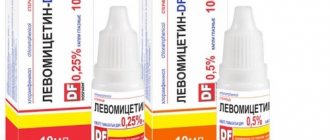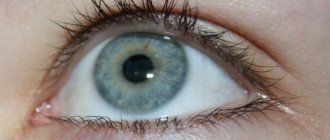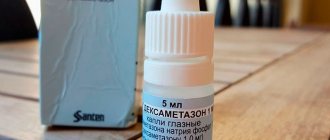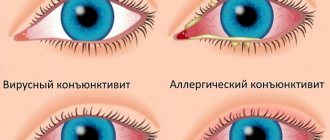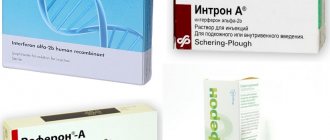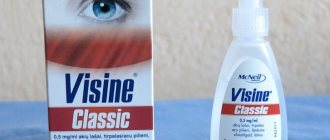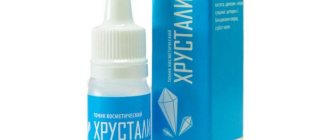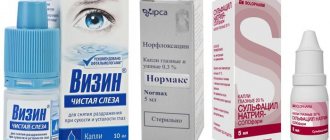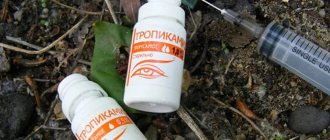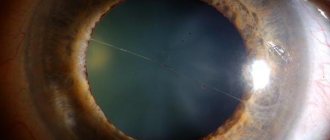Compound
active ingredient:
miramistin;
1 ml of solution contains miramistin 0.1 mg;
Excipients:
sodium chloride, disodium phosphate dodecahydrate, sodium dihydrogen phosphate dihydrate, water for injection.
Dosage form.
Eye/ear/nasal drops.
Basic physical and chemical properties:
colorless transparent liquid.
Pharmacotherapeutic group.
Drugs used in ophthalmology and otology. Decongestants and other drugs for topical use for diseases of the nasal cavity. ATX code S03D, R01A.
Components and principle of operation
The drug contains the main substance - miramistin and such auxiliary ingredients as:
- injection water;
- sodium chloride;
- food additive E339;
- acid salt of the alkali metal sodium and phosphoric acid.
Oftamirin eye drops act locally. Their active substance has anti-putrefactive and antimicrobial properties and has a destructive effect on the cells of pathogenic microorganisms. The medicine has an effect on Gram- and Gram+ bacteria, fungal infections, viruses, including herpes virus infection and Dermatophyte fungi. To some extent, Miramistin suppresses inflammation and improves the human immune system. With proper use of eye drops at the end of the therapeutic course, it will be possible to speed up the recovery process and the affected tissue structures will heal faster.
Pharmacological properties
Pharmacodynamics.
Miramistin is a cationic surfactant with antimicrobial (antiseptic) effect.
The action of miramistin is based on the direct hydrophobic interaction of the molecule with the lipids of the membranes of microorganisms, leading to their fragmentation and destruction. In this case, part of the miramistin molecule, plunging into the hydrophobic portion of the membrane, destroys the supra-membrane layer, loosens the membrane, increases its permeability to high-molecular substances, changes the enzymatic activity of the microbial cell, inhibits enzyme systems, which leads to inhibition of the vital activity of microorganisms and their cytolysis.
Unlike other antiseptics, Miramistin has a highly selective action against microorganisms, since it has virtually no effect on human cell membranes. This effect is associated with a different structure of human cell membranes (much longer lipid radicals, which sharply limit the possibility of hydrophobic interaction of miramistin with cells).
Miramistin has a pronounced antimicrobial effect against gram-positive and gram-negative, aerobic and anaerobic, spore-forming and asporogenous bacteria in the form of monocultures and microbial associations, including hospital strains with multidrug resistance to antibiotics.
It has a detrimental effect on pathogens of sexually transmitted diseases - gonococci, Treponema pallidum, Trichomonas, chlamydia, as well as herpes viruses, human immunodeficiency, etc. It has an antifungal effect on ascomycetes of the genus Aspergillus
and genus
Penicillum
, yeast (
Rhodotorula rubra, Torulopsis gabrata,
etc.) and yeast-like (
Candida albicans, Candida krusei,
etc.) fungi, dermatophytes (
Trichophyton rubrum, Trichophyton mentagrophytes, Trichophyton verrucosum, T. schoenleini, T. violaceum, Epidermophyton Kaufman-Wolf, E. floccosum, Microsporum gypseum, Microsporum canis,
etc.), as well as other pathogenic fungi (for example
Pityrosporum orbiculare
(
Malassezia furfur
) in the form of monocultures and microbial associations, including fungal microflora with resistance to chemotherapeutic drugs. Under the influence of miramistin, the resistance of microorganisms to antibiotics is reduced.
Miramistin has anti-inflammatory and immunoadjuvant effects, enhances local protective reactions, regenerative processes, activates nonspecific defense mechanisms due to modulation of the cellular and local humoral immune response, which accelerates recovery.
Pharmacokinetics.
Miramistin has a local effect. There are no data on the possible penetration of the drug into the systemic circulation.
Clinical characteristics.
Oftamirin 0.1 mg/ml 5 ml N1 eye/ear/nasal drops
Compound
active ingredient: miramistin;
1 ml of solution contains miramistin 0.1 mg;
excipients: sodium chloride, disodium phosphate dodecahydrate, sodium dihydrogen phosphate dihydrate, water for injection.
Dosage form
Eye/ear/nasal drops.
Basic physical and chemical properties: colorless transparent liquid
Pharmacotherapeutic group
Drugs used in ophthalmology and otology. Decongestants and other drugs for topical use for diseases of the nasal cavity. ATX code S03D, R01A.
Pharmacodynamics
Miramistin is a cationic surfactant with antimicrobial (antiseptic) effect.
The action of miramistin is based on the direct hydrophobic interaction of the molecule with the lipids of the membranes of microorganisms, leading to their fragmentation and destruction. In this case, part of the miramistin molecule, plunging into the hydrophobic portion of the membrane, destroys the supra-membrane layer, loosens the membrane, increases its permeability to high-molecular substances, changes the enzymatic activity of the microbial cell, inhibits enzyme systems, which leads to inhibition of the vital activity of microorganisms and their cytolysis.
Unlike other antiseptics, Miramistin has a highly selective action against microorganisms, since it has virtually no effect on human cell membranes. This effect is associated with a different structure of human cell membranes (much longer lipid radicals, which sharply limit the possibility of hydrophobic interaction of miramistin with cells).
Miramistin has a pronounced antimicrobial effect against gram-positive and gram-negative, aerobic and anaerobic, spore-forming and asporogenous bacteria in the form of monocultures and microbial associations, including hospital strains with multidrug resistance to antibiotics.
It has a detrimental effect on pathogens of sexually transmitted diseases - gonococci, Treponema pallidum, Trichomonas, chlamydia, as well as herpes viruses, human immunodeficiency, etc. It has an antifungal effect on ascomycetes of the genus Aspergillus and the genus Penicillum, yeasts (Rhodotorula rubra, Torulopsis gabrata and etc.) and yeast-like (Candida albicans, Candida krusei, etc.) fungi, dermatophytes (Trichophyton rubrum, Trichophyton mentagrophytes, Trichophyton verrucosum, T. schoenleini, T. violaceum, Epidermophyton Kaufman-Wolf, E. floccosum, Microsporum gypseum, Microsporum canis, etc.), as well as other pathogenic fungi (for example, Pityrosporum orbiculare (Malassezia furfur) in the form of monocultures and microbial associations, including fungal microflora with resistance to chemotherapy drugs. Under the influence of Miramistin, the resistance of microorganisms to antibiotics is reduced.
Miramistin has anti-inflammatory and immunoadjuvant effects, enhances local protective reactions, regenerative processes, activates nonspecific defense mechanisms due to modulation of the cellular and local humoral immune response, which accelerates recovery.
Pharmacokinetics
Miramistin has a local effect. There are no data on the possible penetration of the drug into the systemic circulation.
Indications
- In the complex treatment of infectious processes in the anterior part of the eye (blepharitis, conjunctivitis, keratitis, keratouveitis) caused by gram-positive and gram-negative bacteria, chlamydia, fungi and viruses sensitive to miramistin, eye injuries, eye burns (thermal and chemical).
- Prevention of ophthalmia of newborns, including gonococcal and chlamydial.
- Prevention and treatment of purulent-inflammatory eye lesions in the pre- and postoperative period.
- In the complex treatment of acute and chronic external otitis, chronic purulent mesotympanitis, otomycosis.
- In the complex treatment of acute rhinitis.
Contraindications
Increased individual sensitivity to Miramistin or other components of the drug.
Interaction with other drugs and other types of interactions
When used together, Oftamirin increases the effectiveness of topical antibiotics. If you are using any other medicines at the same time, you should inform your doctor.
Features of application
No data.
The ability to influence reaction speed when driving a vehicle or operating machinery
The drug does not affect the reaction rate when driving vehicles or other mechanisms.
Use during pregnancy or breastfeeding
The medicine can be used during pregnancy or breastfeeding.
Directions for use and doses
Ophthalmology.
To treat infectious processes in the anterior part of the eye, adults and children over 12 years old are instilled into the conjunctival sac, 2-3 drops, children under 12 years old - 1-2 drops 4-6 times a day. The duration of treatment usually does not exceed 2 weeks.
In order to prevent complications in the pre- and postoperative period - 2-3 drops 3 times a day 2-3 days before surgery. After surgery - for 3-5 days, 1-2 drops 3 times a day.
When treating eye burns, after washing the eye with plenty of water, carry out frequent instillations (every 5-10 minutes) for 1-2 hours. For further treatment, use the drug for adults and children over 12 years old - 2-3 drops, for children under 12 years old - 1-2 drops 4-6 times a day.
To prevent ophthalmia in newborns, immediately after birth, instill 1 drop of the drug into each eye 3 times with an interval of 2-3 minutes.
Otolaryngology.
In the treatment of acute and chronic external otitis, otomycosis
adults and children over 12 years of age, instill 3-5 drops 4-6 times a day;
children under 12 years old – 2-3 drops 4-6 times a day.
A gauze turunda moistened with a medicine can be inserted into the external auditory canal 4-6 times a day for 10-14 days (instead of instillation).
For chronic mesotympanitis, use in complex treatment using hardware ultrasonic irrigation or injection into the tympanic cavity together with antibiotics.
When treating acute rhinitis, infections of the nasal mucosa, instill 2-3 drops into adults and children over 12 years of age, and 1-2 drops into each nasal passage for children under 12 years of age 4-6 times a day. The course of treatment is 7-14 days.
Dosing features. Precise dosing is achieved by pressing the bottom of the bottle - 1 press = 1 drop.
Children
The drug can be used in pediatric practice.
Overdose
No cases of overdose were observed.
Adverse reactions
When using the drug, hypersensitivity reactions are possible. In some cases, a short-term burning sensation is possible, which disappears on its own after 5-20 seconds and does not require cessation of treatment.
Best before date
3 years.
The medicine should not be used after the expiration date indicated on the packaging, and in cases where the “first opening” control is violated.
After opening the bottle, use the medicine for no more than 28 days.
Storage conditions
Store in the original packaging out of the reach of children at a temperature not exceeding 30 °C. Keep the bottle tightly closed between uses.
Package
5 ml of the drug in a bottle; 1 bottle in a pack.
Vacation category
On prescription.
.
Manufacturer's location and address of place of business
Ukraine, 02093, Kyiv, st. Boryspilskaya, 13.
© Translation into Russian by the editorial team of apteka24.ua.
Source: “State register of medicinal facilities of Ukraine”, 2020.
Indications
In the complex treatment of infectious processes in the anterior part of the eye (blepharitis, conjunctivitis, keratitis, keratouveitis) caused by gram-positive and gram-negative bacteria, chlamydia, fungi and viruses sensitive to miramistin, eye injuries, eye burns (thermal and chemical).
Prevention of ophthalmia of newborns, including gonococcal and chlamydial.
Prevention and treatment of purulent-inflammatory eye lesions in the pre- and postoperative period.
In the complex treatment of acute and chronic external otitis, chronic purulent mesotympanitis, otomycosis.
In the complex treatment of acute rhinitis.
Directions for use and doses
Ophthalmology.
For the treatment of infectious processes in the anterior part of the eye
adults and children over 12 years old are instilled into the conjunctival sac, 2-3 drops, children under 12 years old - 1-2 drops 4-6 times a day. The duration of treatment usually does not exceed 2 weeks.
In order to prevent complications in the pre- and postoperative period -
2-3 drops 3 times a day 2-3 days before surgery. After surgery - for 3-5 days, 1-2 drops 3 times a day.
In the treatment of eye burns
, after washing the eye with plenty of water, carry out frequent instillations (every 5-10 minutes) for 1-2 hours. For further treatment, use the drug for adults and children over 12 years old - 2-3 drops, for children under 12 years old - 1-2 drops 4-6 times a day.
For the prevention of ophthalmia in newborns
Immediately after birth, the child should instill 1 drop of the drug into each eye 3 times with an interval of 2-3 minutes.
Otolaryngology.
In the treatment of acute and chronic external otitis, otomycosis
adults and children over 12 years of age, instill 3-5 drops 4-6 times a day;
children under 12 years old – 2-3 drops 4-6 times a day.
A gauze turunda moistened with a medicine can be inserted into the external auditory canal 4-6 times a day for 10-14 days (instead of instillation).
For chronic mesotympanitis
used in complex treatment using hardware ultrasonic irrigation or injection into the tympanic cavity together with antibiotics.
In the treatment of acute rhinitis, infection of the nasal mucosa
instill 2-3 drops in adults and children over 12 years old, 1-2 drops in each nasal passage for children under 12 years old 4-6 times a day. The course of treatment is 7-14 days.
Dosing features.
Precise dosing is achieved by pressing the bottom of the bottle - 1 press = 1 drop.
Children.
The drug can be used in pediatric practice.
